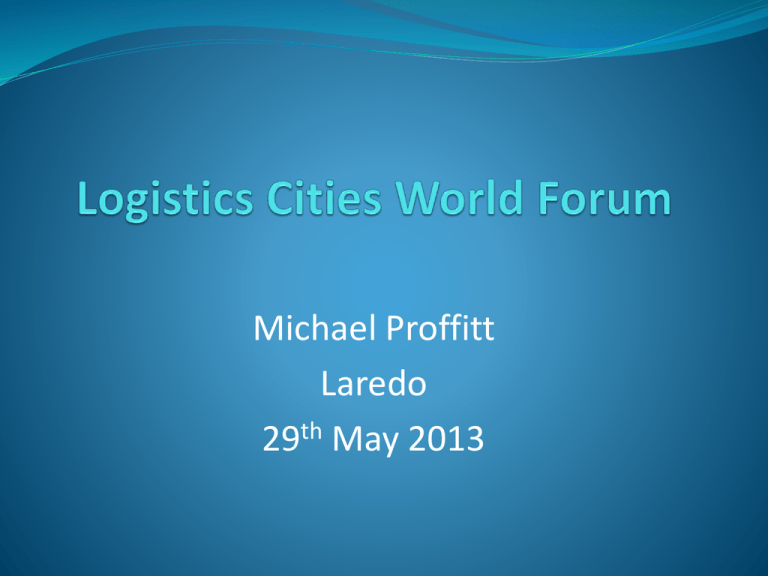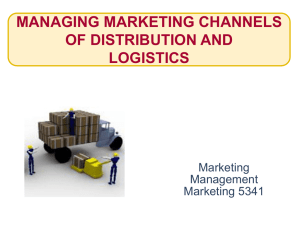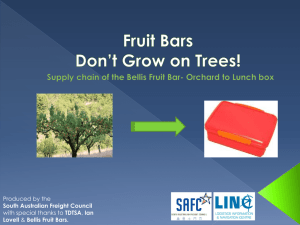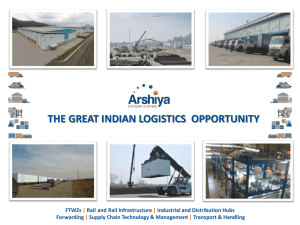Logistics Cities World Forum
advertisement

Michael Proffitt Laredo 29th May 2013 AGENDA Introduction Overview Share Personal Experiences: - Dubai Logistics City - India Key Learnings FIRST OPTION “Build it and they will come” SECOND OPTION UNDERSTAND YOUR MARKET Supply Chains – Visual Representation Procurement Supply Management Demand Planning Sales Data Build Plan Component Suppliers Manufacturers Distribution Customers Key Supply Chain Issues - Summary Forecasting Extended supply chains Environmental issues Collaboration Visibility through the Supply Chain Customs Corruption Security / Risk Infrastructure Complexity of Developments Logistics Clusters Logistics Parks Logistics Villages Logistic Cities Why Develop? Support Ports and Airports Enable Efficient Transit Movement Enable Efficient National Distribution Provide Stockholding Opportunities Allow Value Added Services to be Performed Support Reverse Logistics Key Parties Involved in Developments Users/ Customers Governments Developers Investors What is Required? Adequate Road Network – inside the zone and outside Proximity to Railways IT Infrastructure Adequate Power Container Park and Support Services Truck Facilities Commercial Support Facilities Over-Dimensional Cargo Areas Warehouses People Game Changer Articulate Value Proposition The 4P’s/SAVE PRODUCT/ SOLUTION PLACE/ ACCESS MARKETING MIX PRICE/ VALUE PROMOTION/ EDUCATION 6P’s/SAVE PUBLIC OPINION PLACE/ ACCESS PRODUCT/ SOLUTION MARKETING MIX PROMOTION/ EDUCATION PRICE/ VALUE POLITICAL AUTHORITY Images of Dubai Dubai: Sustainable Growth Through Diversification Oil & Gas Tourism Finance & Banking Trade & Logistics 2 bn consumers in greater region, and growing Healthy growth, liberal business environment Prominent geographical location Create an integrated logistics platform to establish Dubai as the leading hub for the region 19 A Unique Opportunity A visionary approach Thinking long-term Strengthen Dubai as hub for the greater region Create the best trading and distribution environment “Build the world’s first truly integrated logistics platform, with all transport modes, logistics and value added services, including manufacturing and assembly, in a single bonded and Free Zone environment.” 20 Dubai as a Logistics Hub for the Region 2 Billion consumers Solid growth rates The most liberal business environment in the Region The most professional location for distribution business Next step into the future: Integrating logistics into a single platform – a quantum leap for logistics 21 Projected Passenger Growth Dubai International Airport 90.0 82.3 79.3 76.3 80.0 73.2 70.1 67.0 70.0 64.0 60.9 57.7 60.0 54.4 50.8 46.9 50.0 42.9 38.4 40.0 33.7 28.8 30.0 24.8 21.7 20.0 9.1 9.7 10.8 12.3 13.5 16.0 18.1 10.0 0.0 1997 1998 1999 2000 2001 2002 2003 2004 2005 2006 2007 2008 2009 2010 2011 2012 2013 2014 2015 2016 2017 2018 2019 2020 22 2021 Dubai – An Excellent Location for Innovative Logistics… For global supply chains As a hub for the region 23 Dubai’s Logistics Platform Jebel Ali Port and Free Zone Dubai Logistics City Dubai World Central International Airport 24 Jebel Ali Port and Free Zone 14 m. TEU in 2012 #8 world-wide Area of 100+ square kilometers 100,000+ tons sea-air via DXB 7,000+ companies in JAFZA 25 Jebel Ali – Terminal Expansion Extension of existing Terminal 1, with total additional capacity of 5m TEUs Phase 1 will consist of 1.6km of quay, 4 berths, 17m depth alongside, 2.0m TEUs capacity Phase 2 will consist of additional 1km of quay, 3 berths, 17m depth alongside, 3.0m TEUs capacity Estimated Phase 1 operational commencement: July 2007 Demand-led investment, able to cater for Suezmax + vessels (12,000 TEUs) Adjacent to Terminal 1 and, therefore, the Free Zone also Maintain leading position in customer service having the most advanced infrastructure and superstructure Future Possibilities Terminal 2 26 Dubai: Integrated Logistics and Freedom for Business FREE ZONE: No customs duties Integrated LogisticsPlatform No taxes Liberal visa policy Free capital transfer 100% ownership Logistics know-how Quality labor at competitive cost Abundant space 27 Linking DLC and JAFZA Jebel Ali Port and Free Zone Main road Port – DLC (bonded, within Free Zone) Dubai Logistics City Dubai World Central International Airport 28 Dubai Logistics City Dubai Logistics City Master Plan 30 OVERVIEW OF THE INDIAN ECONOMY India has experienced a consistent GDP growth of over 6% in the last decade, and a 7% growth in 2011 (India’s Central Statistical Organization) India has been one of the 10 fastest-growing economies in the world in the last two decades Domestic consumption is the largest contributor to the GDP (58% in FY’11) Foreign exchange reserves totals over US$ 250 billion (as of Dec’11) India ranks 26th in terms of world exporters, contributing over 1.3% of globally consumed merchandise, with exports growing at a rate of 22% India ranks 17th in terms of world importers, consuming over 2% of globally produced merchandise, with a consumption rate growing at 35% (WTO) India’s urbanization rate is the fastest growing in the world. By 2030, over 40% of India’s population will be living in urban areas (U.N. Population Fund) GROWING CONSUMERISM & EVOLVING MIDDLE CLASS By 2025, India will have a middle class population of 583 million people, becoming the world’s 5th largest consumer market (McKinsey Global Institute) Consumption in India will grow in real terms from US$ 378 billion presently to US$ 1.56 trillion by 2025 – a fourfold increase By 2020, India is projected to have an additional 47 million working population, almost equal to the total world shortfall, with an average Indian age of 29 Comparatively, the average population age of other economies at that time will be 37 in China, 45 in the U.S. & Western Europe and 48 in Japan 66% of India's 1.1 billion population is currently under the age of 35 & is expected to outpace China by 2030 The estimated size of India’s real estate market in terms of total economic value of development activity is US$ 40-45 billion, representing 5 - 6 % of GDP, growing at 30% p.a Residential property constitutes almost 75% of the real estate market in India INDIA’S EMERGING MIDDLE CLASS 2 out of the top 5 most populous cities in the world are in India (Mumbai 13 mil & Delhi 12.56 mil) Population in major metro cities in India which exceed 4 million, including the above, are Bangalore, Chennai, Hyderabad, Kolkata, Ahmedabad & Pune Additionally there are 48 agglomerations with a population of 1 million or more Ahmedabad Pune Population > 4 million By 2030, India will have 68 cities with a population of over 1 million, 13 cities of over 4 million & 6 megacities of over 10 million In 2030, India's largest cities will be bigger than many major countries in both population and economic output STRATEGIC POSITIONING Mumbai Singapore BUT IT’S NOT ALL OPTIMISM ………. CHALLENGES OF DOING BUSINESS IN INDIA As per World Bank’s 2010 survey, India is ranked 134th amongst 183 economies in terms of ‘Ease of Doing Business’, - It includes variables such as Starting a Business, Registering Property, Paying Taxes, Trading Across Borders, Enforcing Contracts & Closing a Business As per the Transparency International's Corruption Perception Index, 2010, India ranked 87th out of 178 countries in terms of corruption in public & private sector Delay in legal proceedings & litigations Lack of implementation & enforcement of intellectual property laws Inadequate or lack of infrastructure for supporting the fast pace economic growth, specially in transportation (Road & Rail) and logistics (Ports, Warehousing, Distribution, Hinterland Connectivity & Domestic Consolidation Hubs) Complex Tax structure (Direct & Indirect) Archaic labour & property ownership laws INDIA’S LOGISTICS REALITIES: Leading to Strategic & Operational in-efficiencies for doing business in India Logistics cost in India is high – at around 14% of GDP against 8% - 9% in most developed nations. On a GDP of USD 1.6 trillion, this represents an absolute value of in-efficiency (and therefore logistics market potential) of over USD 65 billion India's level of containerization is less than 25% as against a global average of 60% - 70% The average time taken to clear import & export cargo at ports is about 19 days in India against 3 to 4 in Singapore India's container throughput in CY10 was just over 7.7 million TEU's as compared to Dubai (12 million), Singapore (24 million) & China (186 million) India burns nearly US$2.5 billion worth of fuel on account of trucks standing idle on state check-posts World Bank’s 2010 Logistics Performance Index (LPI) ranks India 47th in terms of logistics in-efficiency as compared to 130 countries globally – in terms of - Customs Clearance, Infrastructure, Timelines, Shipments, Logistics Competences, Tracking & Tracing Transport Challenges CAPITALIZING ON INDIA’S LOGISTICS OPPORTUNITY What does it take? Free Trade Warehousing Zones (FTWZs) Domestic Distriparks To enable EXIM cargo Consolidation, Value Addition and allow India to become a Regional Trading Hub For Domestic distribution, cargo value addition and consolidation for Rail transportation to remove dependency on road Rail Infrastructure Solutions Comprising of innovative Customized Containers for specific product types, Service Level agreements on timeline and deliver with Key Performance Indicators State-Of-The-Art Rail Terminals at strategic locations across India with modern equipment to increase speed of loading/unloading Integrate Logistics Infrastructure with Global Logistics, Domestic Supply Chain Management, Transport & Handling and IT Global ocean & air logistics, domestic forward and reverse supply chain management with ownership on reduction of working capital and product visibility & control, through technology ARSHIYA’S PAN-INDIA INFRASTRUCTURE FOOTPRINT 5 FTWZs – Rail Connected, Planned Pan-India 5 Domestic Distriparks - Planned Pan-India, Complimenting the FTWZ Network Mumbai (Operational since Nov’10), Delhi (Go Live Q2FY’12) followed by Nagpur, Chennai & one in the East First of the Domestic Distriparks (in Khurja near Delhi) operational by Q2FY’12 150 Train Pan-India Rail Operations Providing unique and customized solutions to marquee customers with long term contracts Inducted 15 trains since FEB’09 and one of the most profitable Private Container Train Operators (PCTO) Pan-India Rail Terminal Network complimenting each FTWZ, Domestic Distripark & Rail Operations accelerating cargo distribution through aggregation INDIA’S FIRST - ARSHIYA’S FTWZ IN MUMBAI • 165 Acre State-of-the-Art facility 24 kms from JNPT Port featuring: - 24x7 On-Site Custom Clearance House - State-of-the-Art Infrastructure, Equipment & Facilities - Connectivity to our Pan-India Rail Network accelerating distribution through aggregation at strategic locations MUMBAI FTWZ - JULY 2009 MUMBAI FTWZ - JULY 2009 SAME VIEW – AUGUST 2010 CONTAINER YARD - AUGUST 2009 CONTAINER YARD - SEPTEMBER 2009 CONTAINER YARD - JULY 2010 ARSHIYA’S MUMBAI FTWZ – Warehouse & Main Access Road ARSHIYA’S MUMBAI FTWZ – Customs Office ARSHIYA’S MUMBAI FTWZ – Container Yard & Material Handling Equipment ARSHIYA’S MUMBAI FTWZ – Date Center & Electrical Sub Station ARSHIYA’S MUMBAI FTWZ – Warehouse Interiors & Loading Dock ARSHIYA’S UPCOMING INFRASTRUCTURE – KHURJA (DELHI) • 315 Acre Comprehensive Facility 90 km from Delhi & 53 km from Dadri - Side-by-Side FTWZ (135 Acres) and Domestic Distripark (130 Acres) - Arshiya Rail Infrastructure (50 Acres), including on-site Rail Siding - Operations live as of CY Q2’11 to be joined by similar models in Chennai & Nagpur FTWZ : A GAME CHANGER FOR INDIA India is world’s 2nd largest developing & fastest growing economy just behind China With a population of 1.1 billion, the domestic consumption comprises 58% of GDP Strategically located between South East Asia & Middle East there are 7,000 kms of coastline & unlike China India’s population is evenly spread across hinterland Unlike Dubai, India has a strong manufacturing base where global companies are producing products for domestic as well as export opportunities Logistics infrastructure is the single largest challenge as well as the biggest opportunity for sustaining India’s fast paced GDP growth The FTWZ is a game changer for India Key Learnings Logistics Cities are not Products – they are Supply Chain Enablers Successful Planning and Development Requires Extensive Collaboration The Key Infrastructure must be Planned but then Retain Flexibility Clarifying the Value Proposition is Mandatory Marketing the City to Potential Sectors/Clients needs a very Professional Approach GRACIAS







